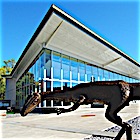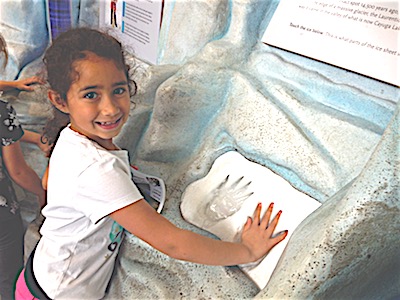- By Dan Veaner
- Around Town
 Print
Print  Lansing 1st graders were greeted by a Coelophysis, stuck their hands in a glacier, and made their own fossils last month. Sounds dangerous, but in reality it was a field trip to the Museum of the Earth, part of the Discovery Trail program, Kids Discover the Trail (KDT). The point is to give children hands-on experience to get them interested in earth science.
Lansing 1st graders were greeted by a Coelophysis, stuck their hands in a glacier, and made their own fossils last month. Sounds dangerous, but in reality it was a field trip to the Museum of the Earth, part of the Discovery Trail program, Kids Discover the Trail (KDT). The point is to give children hands-on experience to get them interested in earth science."The idea is to get students outside the classroom, to have hands-on learning and make concepts tangible, to develop critical thinking skills, and just to have fun," says Discovery Trail Executive Director Star Bressler. "We're going into our 12th year of programs. It's an opportunity to bring elementary school youth into museums and to have hands-on learning experiences so they become interested in science, art, and nature."
The Lansing students loved the statue of a Coelophysis that stands in front of the museum. They were brought into a classroom where for a quick introduction, then broke up into small groups that visited the various 'stations' around the museum. One exhibit features a glacier display that recreates the museum location as it would have been 3 million years ago.
 Where else can a 1st grader stick her hand on a glacier?
Where else can a 1st grader stick her hand on a glacier?"They really seemed to love that glacier," Bressler says. "The hand print in that photo is made of ice, so it's cold like a real glacier. The interesting thing about that glacier is learning about what things were like millions of years ago."
Another station featured boxes of objects. Students reached into the boxes and tried to guess whether the object inside was once a living creature or not. One had a tooth. Another had an arrow head. They dug for fossils at another station. Museum docents explained what the fossils were and students got to take them home. Another exhibit feathered a replica of an extinct flying reptile. The 1st graders also made their own fossils out of silly putty.
 Afterwards each student received a free book, and teachers optionally followed up with activities in their classrooms. Bressler says one of the program goals is to provide equal access to local museums that some families might not otherwise visit. In addition to the book, each student is given a return pass they can use for one free visit for their whole family.
Afterwards each student received a free book, and teachers optionally followed up with activities in their classrooms. Bressler says one of the program goals is to provide equal access to local museums that some families might not otherwise visit. In addition to the book, each student is given a return pass they can use for one free visit for their whole family."My son was so excited about his 1st grade class trip to the Museum of the Earth," said one Lansing 1st grader's parent. "A week later he is still talking about it. We plan to use the free return pass with our whole family to explore the museum together."
Bressler works with education and marketing staff at the eight museums who help with the program. The program is also dependent on volunteers. Although she is only in her first year as Discovery Trail Executive Director, she says she has already received a lot of positive feedback.
"It's been fun coming into this job because I meet a lot of parents," she says. "We want to expand to all six school districts within Tompkins County. We started with a pilot program of Lansing 1st graders going to the Museum of the Earth in the 2014-15 school year. This year we continued with that."
The program was started by Ithaca Public Education Initiative (IPEI) in Ithaca in 2004. Now in its 12th year it has expanded to most Tompkins County school districts, and Bressler says she hopes to add more grade levels. In addition to Ithaca, Groton 2nd and 5th graders, all the grades in Trumansburg, 1st, 2nd and 5th grades in Newfield (and adding 4th grade next year). Lansing's 1st grade signed on last year. Bressler is hoping to add Dryden next year.
Bressler says she would like to add more grades from Lansing. The different grade levels go to one of eight local museums or institutions that partner with the program. Pre-K students are taken to the Johnson Museum of Art. Kindergartners go to the Tompkins County Public Library. 1st graders go to the Museum of the Earth. 2nd graders go to the Sciencecenter to learn about renewable energy and to build wind turbines. 3rd graders go to Cornell Plantations to learn about wild flowers and botany. 4th graders go to the History Center's Eight Square School House in Dryden to learn about going to school in the 1890s. 5th graders go to the Cayuga Nature Center for a ropes course, and to the Cornell Lab of Ornithology to learn about birds and their habitats.
3,780 students have benefited from the program last school year including 36% who qualify for free/reduced lunch. This year 3,850 students are participating, including 89 from Lansing. 30,399 have participated since the program began. 91% of participating teachers said the program enhances their school experience, and 96% said they plan to participate in the future. The program is funded through grants and state funding through BOCES. Last year the KDT raised $64,750.
v12i21



